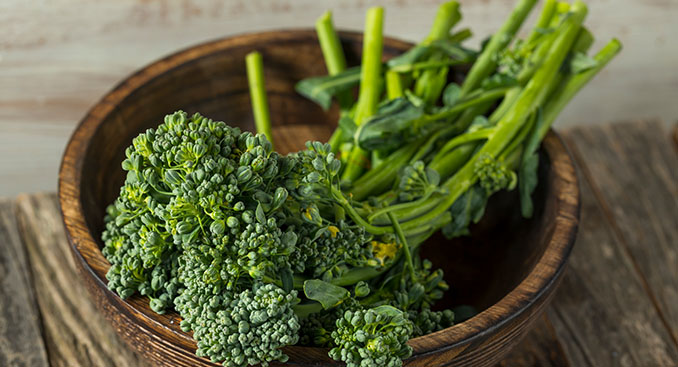Brocolli Rabe: A Green Goddess

First thing’s first: Broccoli rabe is not a type of broccoli. Also called rapini, this leafy green is—like broccoli—a cruciferous vegetable, but it’s more closely related to turnips. In fact, in some parts of Italy, broccoli rabe is called cime della rapa, or “tops of the turnip.” Its large leafy stems do somewhat resemble the heads of turnips and other leafy greens, but its buds have clusters of broccoli-like florets. (Note: Broccoli rabe should not be confused with broccolini, which resembles long broccoli stalks.) Known for its bitter yet nutty taste, rapini is a staple in many southern Italian dishes—and is a main ingredient in the country’s “most popular sandwich.” (Soppressata and rapini, anyone?) And it has an array of health benefits to boot.
Power Up
One cup of raw broccoli rabe has only about nine calories and .2 grams of fat (this, of course, doesn’t take into account the olive oil or heavy Italian sauces that the vegetable is often cooked in). But the pièce de résistance is the nutrients it contains: notably, almost 90 milligrams of vitamin K (or more than 100 percent of the daily recommended value), which promotes blood and bone health.
It also has generous amounts of immune-boosting vitamins A (21 percent) and C (13 percent), iron (5 percent) and lutein, which is beneficial for eyesight. It also works to cleanse the body: 33.2 micrograms (8 percent) of folate help with liver function, and 1 gram of fiber promotes digestion. Finally, the vegetable contains a small amount (45.2 mg) of omega-3 fatty acids, useful for brain function.
Buy|Store|Serve
Though broccoli rabe is in season through the end of June, it can be found in the produce section of most supermarkets all year long. Look near the other bitter greens, like kale and mustard greens, and select a bundle that is crisp, sturdy and a vibrant green color, without any browning or yellowing. It can be stored in a refrigerator wrapped in plastic for about five days.
The major hurdle in cooking this vegetable is overcoming its acrid flavor. Chefs offer several solutions: Blanching it in boiling water followed by an ice bath brings out its sweetness, and a splash of lemon or apple cider vinegar also works well to counterbalance the bitterness. Chef Steve Dunn wrote in Cooks Illustrated that after experimenting, he found that keeping the leafy tops intact while cutting the stems into bite-size pieces before blanching or roasting also did the trick.
Broccoli rabe is a common ingredient in a diverse range of cuisines, from Chinese to Italian. It can be used in place of spinach in recipes, or as a side dish, topped with olive oil and garlic. It pairs well with pasta or Italian sausage, and can be used in sauces, on pizza, and even in lasagna.